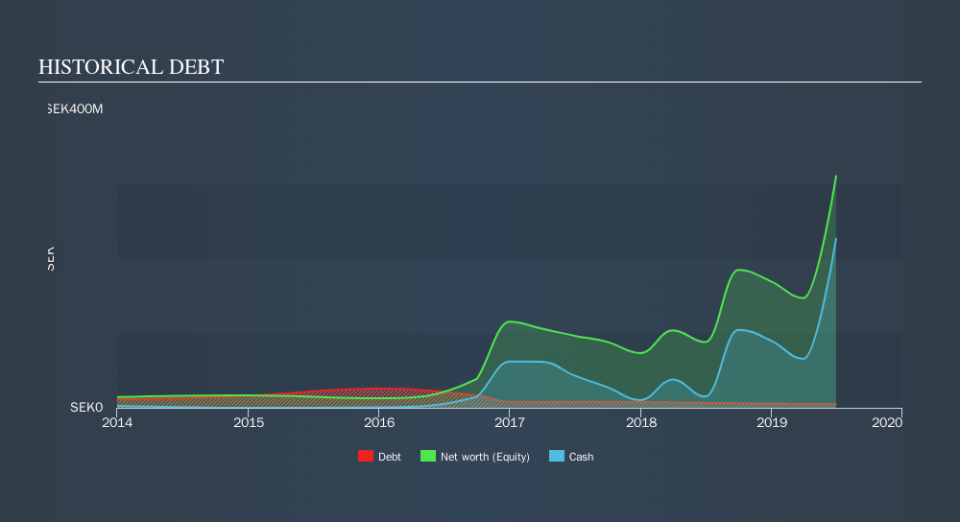Is Smart Eye (STO:SEYE) A Risky Investment?

The external fund manager backed by Berkshire Hathaway's Charlie Munger, Li Lu, makes no bones about it when he says 'The biggest investment risk is not the volatility of prices, but whether you will suffer a permanent loss of capital. It's only natural to consider a company's balance sheet when you examine how risky it is, since debt is often involved when a business collapses. We note that Smart Eye AB (publ) (STO:SEYE) does have debt on its balance sheet. But is this debt a concern to shareholders?
When Is Debt Dangerous?
Generally speaking, debt only becomes a real problem when a company can't easily pay it off, either by raising capital or with its own cash flow. Ultimately, if the company can't fulfill its legal obligations to repay debt, shareholders could walk away with nothing. However, a more common (but still painful) scenario is that it has to raise new equity capital at a low price, thus permanently diluting shareholders. Having said that, the most common situation is where a company manages its debt reasonably well - and to its own advantage. When we think about a company's use of debt, we first look at cash and debt together.
Check out our latest analysis for Smart Eye
What Is Smart Eye's Net Debt?
The image below, which you can click on for greater detail, shows that Smart Eye had debt of kr4.67m at the end of June 2019, a reduction from kr6.67m over a year. However, its balance sheet shows it holds kr226.9m in cash, so it actually has kr222.2m net cash.
How Healthy Is Smart Eye's Balance Sheet?
We can see from the most recent balance sheet that Smart Eye had liabilities of kr35.9m falling due within a year, and liabilities of kr2.67m due beyond that. Offsetting these obligations, it had cash of kr226.9m as well as receivables valued at kr10.3m due within 12 months. So it actually has kr198.6m more liquid assets than total liabilities.
This short term liquidity is a sign that Smart Eye could probably pay off its debt with ease, as its balance sheet is far from stretched. Succinctly put, Smart Eye boasts net cash, so it's fair to say it does not have a heavy debt load! When analysing debt levels, the balance sheet is the obvious place to start. But ultimately the future profitability of the business will decide if Smart Eye can strengthen its balance sheet over time. So if you want to see what the professionals think, you might find this free report on analyst profit forecasts to be interesting.
Over 12 months, Smart Eye reported revenue of kr77m, which is a gain of 23%, although it did not report any earnings before interest and tax. With any luck the company will be able to grow its way to profitability.
So How Risky Is Smart Eye?
By their very nature companies that are losing money are more risky than those with a long history of profitability. And the fact is that over the last twelve months Smart Eye lost money at the earnings before interest and tax (EBIT) line. Indeed, in that time it burnt through kr81m of cash and made a loss of kr73m. While this does make the company a bit risky, it's important to remember it has net cash of kr222.2m. That means it could keep spending at its current rate for more than two years. Smart Eye's revenue growth shone bright over the last year, so it may well be in a position to turn a profit in due course. Pre-profit companies are often risky, but they can also offer great rewards. For riskier companies like Smart Eye I always like to keep an eye on the long term profit and revenue trends. Fortunately, you can click to see our interactive graph of its profit, revenue, and operating cashflow.
If, after all that, you're more interested in a fast growing company with a rock-solid balance sheet, then check out our list of net cash growth stocks without delay.
We aim to bring you long-term focused research analysis driven by fundamental data. Note that our analysis may not factor in the latest price-sensitive company announcements or qualitative material.
If you spot an error that warrants correction, please contact the editor at editorial-team@simplywallst.com. This article by Simply Wall St is general in nature. It does not constitute a recommendation to buy or sell any stock, and does not take account of your objectives, or your financial situation. Simply Wall St has no position in the stocks mentioned. Thank you for reading.

